英文介绍厦门三日游PPT课件
《英文介绍厦门》课件

Minnan Culture is a branch of Hokkien culture, which is an important part of Chinese culture It is characterized by the unique history, geography, language, custom, and tradition of the people in the Fujian region
These hospitals have advanced medical equipment and technologies, as well as a group of experienced doctors They can provide high quality medical services for local residents and visitors In addition, with the continuous improvement of medical insurance system, local residents' medical security has been greatly improved
Location
01
The botanical garden is located in the north of Xiamen Island, covering an area of more than 10000 square meters
Characteristics
02
The garden has a wide range of plants, including various flowers, trees, and shrubs It is a good place to relax and enjoy nature
厦门旅游景点介绍英文ppt课件
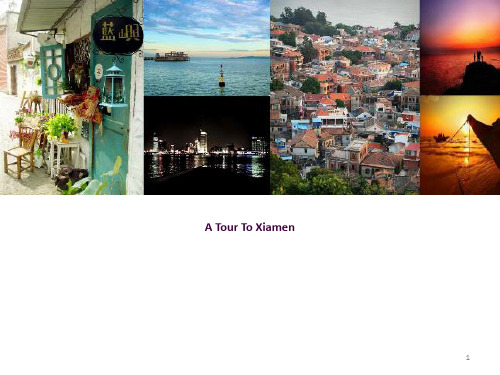
Appreciate the beautiful scenery of the campus and unique architecture
7
How To Get There
The Third Spot
Zhongshan Road 中山路
Lots of people come here for shopping and delicious food every day.
5
The Second Spot
Xiamen University 厦门大学
Xiamen University is considered to be one of the most beautiful campuses in China, and is a major tourist destination in Xiamen.
9
10
How To Get There
11
The Fourth Spot Taiwan Snack Street 台湾小吃街
12
There is only one thing you can do Taiwan Snack Street that is enjoying all kinds of wonderful snacks.
2
The First Spot
South Putuo Temple 南普陀寺
The South Putuo Temple is located on the southwest of Xiamen Island. It is surrounded by the graceful sea and the Wulao Peaks behind the temple. South Putuo Temple has many deep caves and verdant woods.
英文介绍厦门简易PPT课件
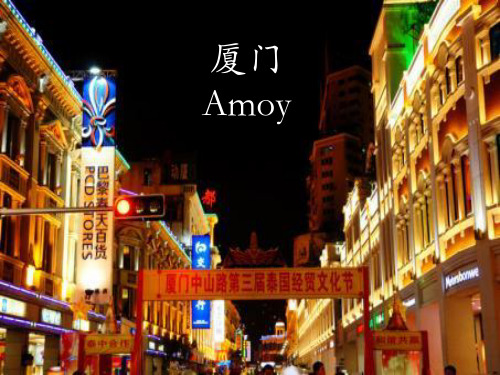
讲师:XXXXXX XX年XX月XX日
பைடு நூலகம்
1.Noodles with satay sause
2. Xiamen style jelly seaworm
3.The ginger female duck
Scenic spots and historical sites
• There are a great variety of sights to witness in Xiamen.Gulangyu Island, the most beautiful island near Xiamen, has won great reputation for its Sunlight Rock and Shuzhuang Garden.South Putuo Temple, which is located at the foot of Wulaofeng and is deemed to be the most renowned Buddhist temple in Xiamen.Xiamen Botanical Garden, known as the Wanshi Botanical Garden,which has scenic spots such as the Morning Bell of Heaven, the Reading and Music Playing Cave, the Cloud Locking Stones, the Jade Scepter Rock and the Peace Stone.
Xiamen is located in Southeast of Fujian province,it is considered as the cleanest port city in China thus people call Xiamen "the garden on the sea" or call it "green island". Back to Song dynasty it started its administrative founding until now.
厦门旅游景点介绍英文
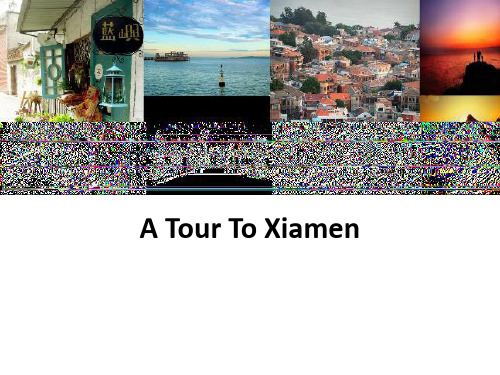
Things To Do
Appreciate the buildings Taste vegetarian dishes Enjoy the beauty of
scenery Pray for happiness and
good health
How To Get There
The Second Spot Xiamen University 厦门大学
The First Spot South Putuo Temple
南普陀寺
The South Putuo Temple is located on the southwest of Xiamen Island. It is surrounded by the graceful sea and the Wulao Peaks behind the temple. South Putuo Temple has many deep caves and verdant woods.
How To Get There
The Fourth Spot
Taiwan Snack Street 台湾小吃街
There is only one thing you can do Taiwan Snack Street that is enjoying all kinds of wonderful snacks.
How To Get There
END
Thank You
A Tour To Xiamen
Xiamen is a well-known tourism city in the Southeast coast of China.
Not only being wealthy with travel resources, it has also temperate weather, fast and convenient transport. All makes Xiamen one of the most suitable cities for tourists in China.
英文介绍厦门三日游
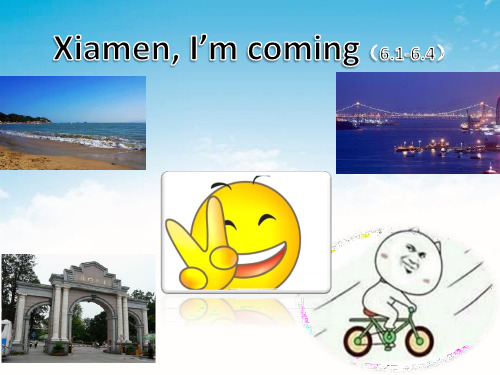
Dingaozai Cat Street
Return to Home Inn
Day 2
• 1. Zen Cuo An (曾厝垵) • 2. White Wall Beach (白城沙滩)
• Travel mode:No.15 bus • Hotel: Home Inns • Price: 1 yuan • Time: 1 hour
Zhongshan Road (7:00-9:30)
Reture to Home Inn(22:00 p.m.)
Have an early rest(23:00 p.m.)
Nanputuo Temple
Xiamen University
Dingaozai Cat Street
Time: 9:00 Travel Mode: On foot Home Inn ——Nanputuo Temple
9:20
Pray for happiness and good health
Trip Route
Day 1:Nanputuo Temple-Xiamen University-Cat Street Day2:Zengcuoan- White Wall Beach Day3:Sunlight Rock-Bright Moon Garden -Shu Zhuang
Garden
308yuan
Nei Cuo Ao Ferry Terminal
200yuan
Others costs: for bus staion
40yuan
For other landmark tickets For delicious foods
200yuan 400yuan
Preparation
厦门旅游景点介绍英文
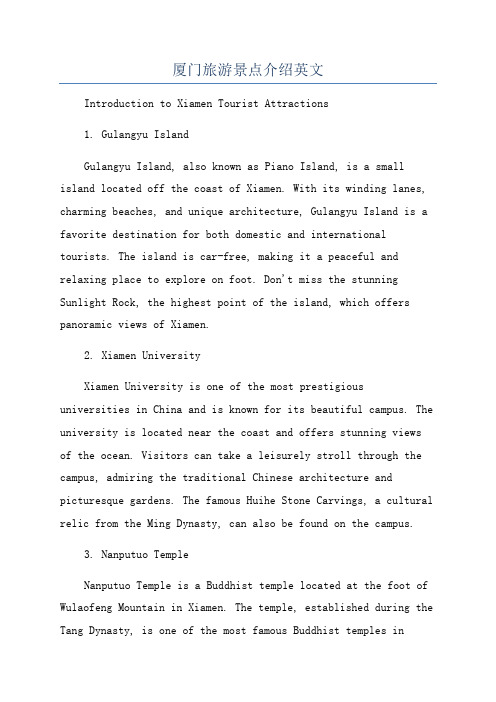
厦门旅游景点介绍英文Introduction to Xiamen Tourist Attractions1. Gulangyu IslandGulangyu Island, also known as Piano Island, is a small island located off the coast of Xiamen. With its winding lanes, charming beaches, and unique architecture, Gulangyu Island is a favorite destination for both domestic and international tourists. The island is car-free, making it a peaceful and relaxing place to explore on foot. Don't miss the stunning Sunlight Rock, the highest point of the island, which offers panoramic views of Xiamen.2. Xiamen UniversityXiamen University is one of the most prestigiousuniversities in China and is known for its beautiful campus. The university is located near the coast and offers stunning views of the ocean. Visitors can take a leisurely stroll through the campus, admiring the traditional Chinese architecture and picturesque gardens. The famous Huihe Stone Carvings, a cultural relic from the Ming Dynasty, can also be found on the campus.3. Nanputuo TempleNanputuo Temple is a Buddhist temple located at the foot of Wulaofeng Mountain in Xiamen. The temple, established during the Tang Dynasty, is one of the most famous Buddhist temples inSouthern China. With its serene atmosphere and stunning architecture, Nanputuo Temple attracts both tourists and devout Buddhists. Inside the temple, visitors can admire the exquisite statues, intricate carvings, and beautiful gardens.4. Hulishan FortressHulishan Fortress, located on the southern coast of Xiamen, is a well-preserved coastal defense fortress built during the late Qing Dynasty. The fortress is famous for its giant cannons, which were used to protect Xiamen from invaders. Visitors can explore the fortress and learn about its history through the various exhibitions and displays. The fortress also offers panoramic views of the sea and is a popular spot to watch the sunset.5. Zhongshan Road6. Xiamen Botanical GardenXiamen Botanical Garden is a vast botanical garden located on the east side of Xiamen. With its diverse collection of plants and flowers, as well as serene water features and pavilions, the garden is a peaceful oasis in the city. Visitors can take a leisurely walk along the winding paths, explore the various themed gardens, and enjoy the tranquility of nature.7. Xiamen Bailuzhou ParkBailuzhou Park, located on Bailuzhou Island in the center of Xiamen, is a popular recreational area for both locals and tourists. The park features lush green spaces, a lake with paddleboats, and various recreational facilities. Visitors can relax in the park, take a boat ride on the lake, or enjoy the lively atmosphere during cultural events and performances.In conclusion, Xiamen offers a wide range of tourist attractions that cater to different interests. From the picturesque Gulangyu Island to the historical Hulishan Fortress, there is something for everyone to enjoy in this coastal city. Whether you are interested in exploring the natural beauty, immersing yourself in the local culture, or simply relaxing in peaceful surroundings, Xiamen is a destination that should not be missed.。
英文介绍厦门(课堂PPT)
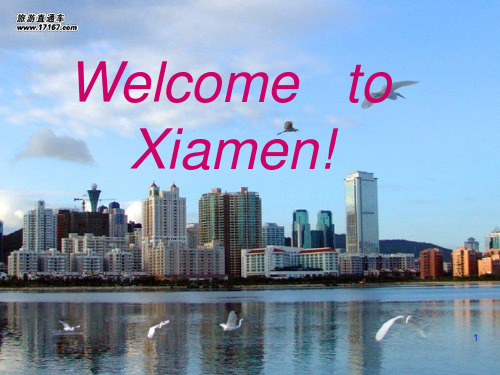
The jiageng buildings 嘉庚楼群
16
Luxun Museum 鲁迅纪念馆
17
Built south hall 建南大礼堂
18
Zhong Linmei square 钟林美广场 19
Qunxian buildings 群贤楼群
20
The lotus lake 芙蓉湖 21
❖ Religion: Buddhism,
Christianity, Islamism,
Catholicism.
5
climate
❖ Subtropical monsoon climate.
❖ Annual average temperature is 21℃ .
❖ Typhoon lasts from July to September (4-5 times).
Valley Of Love 情人谷 22
Food
❖ Xiamen cuisine represents that of the whole of Fujian. It is one of the eight most famous Chinese cooking styles.
❖ It is famous for seafood, herbal dishes, Putuo vegetable dishes and local snacks.
2
Geography
❖ Xiamen is situated on the southeast coast of Fujian Province and at the estuary of Jiulong River.
❖ It is administered as a sub-provincial city of Fujian province with an area of 1,573.16 square kilometers. 3
厦门旅游景点介绍英文
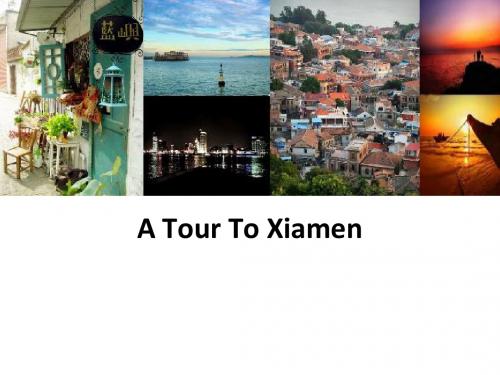
The First Spot
South Putuo Temple 南普陀寺
The South Putuo Temple is located on the southwest of Xiamen Island. It is surrounded by the graceful sea and the Wulao Peaks behind the temple. South Putuo Temple has many deep caves and verdant woods.
A Tour To Xiamen
Xiamen is a well-known tourism city in the Southeast coast of China.
Not only being wealthy with travel resources, it has also temperate weather, fast and convenient transport. All makes Xiamen one of the most suitable cities for tourists in China.
Things To Do
Appreciate the beautiful scenery of the campus and unique architecture
How To Get There
The Third Spot
Zhongshan Road 中山路
Lots of people come here for shopping and
How To Get There
END
Thank You!
delicious food every day.
厦门旅游介绍英文版

Vegetarian Cocktail Spring Roll
Sponge Crab Soup
Ingredients:
Crab ,Tofu ,Sponge , Shallot ,Ginger
Ingredients: Pomfret ,Lobster ,Shallot , Lard
Pomfret Steamed With Lobster
Minorities
• About 20 minorities live in Xiamen • Hui , Manchu , Miao & etc
Tusundong
Xiamen special jell made of sea worm
Springroll
Vegetarian Spring Roll
厦门旅游roduction
Xiamen, the second largest city in Fujian province next to the capital Fuzhou, covers a total area of 1,516 square meters. As one of the five earliest special economic zones, with heavy investment from Taiwan and Hong Kong, it has been a city growing in strength.
Very comfortable & convenient
First Class Seat
Second Class Seat
1. A special custom taken place during the Midautumn Festival . 2. People play it in daily life nowadays.
厦门之旅英文介绍
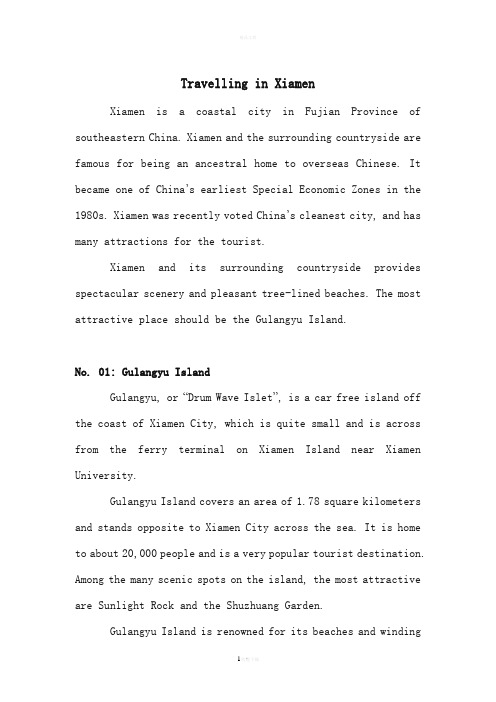
Travelling in XiamenXiamen is a coastal city in Fujian Province of southeastern China.Xiamen and the surrounding countryside are famous for being an ancestral home to overseas Chinese. It became one of China’s earliest Special Economic Zones in the 1980s. Xiamen was recently voted China’s cleanest city, and has many attractions for the tourist.Xiamen and its surrounding countryside provides spectacular scenery and pleasant tree-lined beaches. The most attractive place should be the Gulangyu Island.No. 01: Gulangyu IslandGulangyu, or “Drum Wave Islet”, is a car free island off the coast of Xiamen City, which is quite small and is across from the ferry terminal on Xiamen Island near Xiamen University.Gulangyu Island covers an area of 1.78 square kilometers and stands opposite to Xiamen City across the sea. It is home to about 20,000 people and is a very popular tourist destination. Among the many scenic spots on the island, the most attractive are Sunlight Rock and the Shuzhuang Garden.Gulangyu Island is renowned for its beaches and windinglanes and its varied architecture. The island is on China’s list of National Scenic Spots and also ranks at the top of the list of the ten most-scenic areas in Fujian Province.Gulangyu IslandNo. 02: Oversea Chinese MuseumLocated at the foot of Fengchao Hill, the Xiamen Overseas Chinese Museum is a comprehensive museum that highlights the history of overseas Chinese, and the only Chinese museum set up by overseas Chinese.The Oversea Chinese Museum was founded by the Chinese philanthropist Chen Jiageng. It is a building with a building area of more than 3,000 square meters, displaying more than 7000 exhibits. Special exhibitions of the museum include Unearthed Mummies in Xinjiang, Inner Mongolian Folk Relics and Ancient Technological Achievements of Chinese Agriculture, etc. No. 03: Nanputuo TempleThe Nanputuo Temple is located on the southeast of Xiamen Island. It is surrounded by the graceful sea and the Wulao Peaks behind the temple.Nanputuo literally means South Putuo.Putuo referring to the mountain in Zhejiang province. The buildings include Devajara Hall (the Hall of Heavenly Kings), Mahavira Hall (Daxiongbaodian), Dabei Hall (the Hall of Great Compassion) and a Pavilion built in 1936.The monks of Nanputuo are often seen on the nearby busy downtown streets. The Nanputuo Temple is a very famous Buddhist temple founded in the Tang era.No. 04: Hulishan FortressHulishan Fortress, which is a spectacular site surrounded by walls made of granite and impressive gates, is located at the southern tip of Xiamen Island.Hulishan Fortress was built in 1891, occupying an area of 13,000 square meters.Its buildings are distinctively preserved to the military style of the Ming Dynasty and also that of the Qing Dynasty.The fortress is composed of the barracks, a secret tunnel, a tower, a sentry platform, the ammunition depot, the trench, and the castle. .The German-made Krupp Cannon is the largest existing coast cannon of its kind in the world.No. 07: Zhongshan Road in XiamenWalking along Zhongshan Pedestrian Street(中山路步行街) in Xiamen is worth your valuable time for your short trip to Xiamen. Most visitors would come to Zhongshan Walking Street either before or after going to Gulangyu Island since the west starting point of Zhongshan Road is just across the ferry terminal.Avoid going to the Zhongshan Walking Street on weekends orChina holidays. Zhongshan Road is bright and alive at night with different colours. Zhongshan Road is teeming with shops and street vendors. Zhongshan Road is more than just a commercial street, it is a leisure, entertainment and food center in Xiamen.Over 200 shops lines up the street with clear chain store outlets and trinket shops. Most of the buildings along the Zhongshan Road are a combination of Victoria-era and Chinese traditional architectures, a kind of two-storey buildings known as “Qi Lou”(riding across buildings). Qi Lou is designed both for commerce and living.No. 08 Sunlight RockSunlight Rock is also known as Dragon Head Hill. As the highest point of Gulangyu Island, Sunlight Rock Scenic Areaincludes Sunlight Rock and Piano Garden.There is a saying that if you haven’t ascended Sunlight Rock, you haven’t really been to Xiamen Perched atop Sunlight Rock is a gigantic stone with a diameter of over 40 meters.Sunlight Rock Temple is one of the four top Buddhist temples in Xiamen. The temple was first built in the Ming Dynasty and was famed far and wide, attracting accomplished monks throughout the dynasties. Connected to Sunlight Rock through the cable car, Piano Garden is another attraction for tourists.No. 09: Xiamen UniversityXiamen University, which is one of the comprehensive universities directly affiliated with the Education Ministry, is located in the city of Xiamen in Fujian Province.Xiamen University was founded in 1921 by Tan Kah Kee, the well-known patriotic overseas Chinese leader.XiamenUniversity, a picturesque campus nestled between the sea and the “Five Old Men” mountains, is largely considered to be the most beautiful campus in China.No. 10: Island Ring Road in XiamenXiamen Island Ring Road is a 4-6 lane seaside road totally 43km in length, a green belt that offers tourists a perfect place to bike along beautiful seashores.The best part of the island ring road starts from the Baicheng Beach from Xiamen University to the Xiamen International Conference and Exhibition Center, a 10km ring road from south to the east. You may rent a bike or tamden to cycle the 10km island ring for about 2 hours.You also can visit some interesting sights like Hulishan Fortress, parks along the ring road and walkway boards by the sea. If you have strong legs, you can walk the 10km highlight of the island ring road, a paradise for leisure travelers enjoying the blue sky, beach and green belts along the seashores.Most of the bike rentl shops start from 08:00 am and close at 9:00pm. Amountain bike costs about 10 to 15 yuan/hour with a deposit of RMB300. Tandem bicycles are charged at a higherrate.Many beautiful pictures :欢迎您的下载,资料仅供参考!致力为企业和个人提供合同协议,策划案计划书,学习资料等等打造全网一站式需求。
英文介绍厦门

Geography
Xiamen and the surrounding southern Fujian countryside are the ancestral home to large communitAsia and Taiwan.
Scenic spot
Gulangyu Island Nanputuo Temple Xiamen University Wanshiyan Jimei
Part 01 Gulangyu Island
Gulangyu Island
Gulangyu, separated from Xiamen by the 500-metre-wide Egret River, with an area of 1.77 square kilometres, enjoys a title "Garden on the Sea."
Dream world厦门 观音山梦幻 海岸
Baicheng city beach 白城沙滩
Part 02
Huli Ancient Fortress 胡 里山炮台
The jiageng buildings 嘉庚楼 群
Luxun Museum 鲁迅纪念 馆
Built south hall 建南大礼堂
Fujian Pie (福建馅饼)
Thank you for your listening!
Welcome to Xiamen!
Xiamen is a well-known tourist port city in the Southeast coast of China. It is one of the Cleanest Cities of China, the Garden Cities of China, the National Environmental Protection Model Cities, and the best sightseeing cities in China.
英语介绍厦门
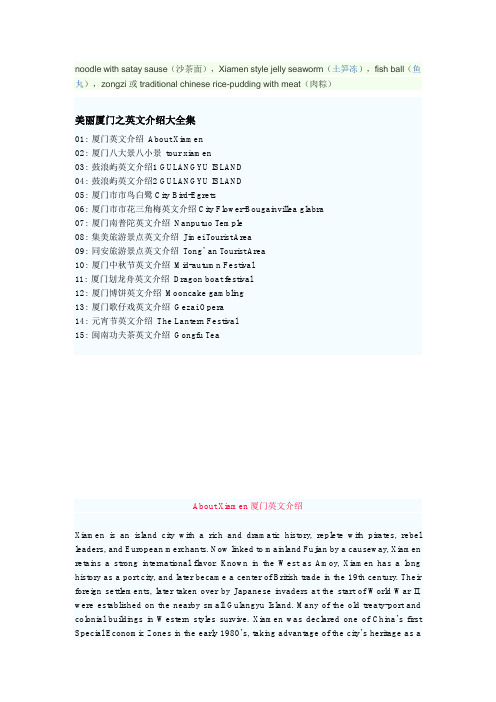
noodle with satay sause(沙茶面),Xiamen style jelly seaworm(土笋冻),fish ball(鱼丸),zongzi或traditional chinese rice-pudding with meat(肉粽)美丽厦门之英文介绍大全集01: 厦门英文介绍About Xiamen02: 厦门八大景八小景tour xiamen03: 鼓浪屿英文介绍1 GULANGYU ISLAND04: 鼓浪屿英文介绍2 GULANGYU ISLAND05: 厦门市市鸟白鹭City Bird-Egrets06: 厦门市市花三角梅英文介绍City Flower-Bougainvillea glabra07: 厦门南普陀英文介绍Nanputuo Temple08: 集美旅游景点英文介绍Jimei Tourist Area09: 同安旅游景点英文介绍Tong’ an Tourist Area10: 厦门中秋节英文介绍Mid-autumn Festival11: 厦门划龙舟英文介绍Dragon boat festival12: 厦门博饼英文介绍Mooncake gambling13: 厦门歌仔戏英文介绍Gezai Opera14: 元宵节英文介绍The Lantern Festival15: 闽南功夫茶英文介绍Gongfu TeaAbout Xiamen厦门英文介绍Xiamen is an island city with a rich and dramatic history, replete with pirates, rebel leaders, and European merchants. Now linked to mainland Fujian by a causeway, Xiamen retains a strong international flavor. Known in the West as Amoy, Xiamen has a long history as a port city, and later became a center of British trade in the 19th century. Their foreign settlements, later taken over by Japanese invaders at the start of World War II, were established on the nearby small Gulangyu Island. Many of the old treaty-port and colonial buildings in Western styles survive. Xiamen was declared one of China’s first Special Economic Zones in the early 1980’s, taking advantage of the city’s heritage as atrading center and the proximity to Taiwan. Today Xiamen is one of China’s most attractive and best-maintained resort cities.Xiamen was founded in 1394 at the beginning of the Ming dynasty as a center of defense against coastal pirates. Its prosperity was due to its deepwater sheltered harbor, that supplanted nearby Quanzhou, the port that had been the center of the maritime trade with the Indies.In the mid-17th century, Xiamen and Gulangyu Island became a stronghold of Zheng Chenggong, known in the West as Koxinga, a Ming loyalist who held out against the Manchu invaders until being driven to Taiwan. Born in Japan to a Chinese pirate father and a Japanese mother, Zheng became allied with holdout Ming princes in the south who hoped for a restoration. He built up a resistance force of some 7,000 junks and a mixed force of three-quarters of a million troops and pirates. In 1661 he drove the Dutch from Taiwan and set up another base there, before his death in 1662.After the Opium Wars Xiamen became one of the first treaty ports to be opened to foreign trade and settlement following the Treaty of Nanjing in 1842. Gulangyu Island was transformed into an international settlement, where many Victorian and Neoclassical style buildings still survive. The city’s prosperity was due both to trade and to wealth sent back by Xiamen’s substantial emigrant community of overseas Chinese.Prosperity returned to Xiamen in the early 1980’s when Xiamen was designated one of the four Special Economic Zones (SEZs).tour xiamen (旅游厦门,八大景八小景)Xiamen is a well-known tourist port city in the Southeast coast of China. It is one of the Cleanest Cities of China, the Garden Cities of China, the National Environmental Protection Model Cities, and the best sightseeing cities in China. Not only being wealthy with travel resources, Xiamen has also temperate weather, fast and convenient transport and communication, and complete travel establishments.In the old times, there were "Eight Major Landscapes" and "Eight Minor Landscapes" "Landscapes Beyond Landscapes" in Xiamen and altogether 24 scenic spots were included in the three general terms. Some of the 24 sights, such as "Wonderland of Gulang", "Five Old Gentlemen Reaching the Clouds", "Watching Sunrise on Hongji Summit", "Night Moon by Tiger Brook", "White Deer Spurting Smoke", still can be traced today.By reorganizing old landscapes and developing new sceneries, Xiamen has formed five main T ourist areas-- Gulangyu Island Tourist Area, Nanputuo Temple T ourist Area, Wangshi Rock T ourist Area, Huangcuo T ourist Area and Jimei T ourist Area. Beside its richful travel resources and pleasant weather, Xiamen also provides fast and convenient transportation and communication, and complete travel establishments. All makes Xiamen one of the most suitable cities for investors and tourists in China.鼓浪屿英文介绍1 GULANGYU ISLANDA ten-minute ferry ride off the southwest side of Xiamen, the 2 square km (3/4 sq. mile) Gulangyu Island (Island of Blown Waves) was the center for foreign communities who settled here after 1842. Many built Western-style mansions, churches, warehouses, and government buildings which still survive. Sunlight Rock (Riguang Yan) dominates the island from its modest 93-meter height. The island includes a statue of Koxinga and a Koxinga Museum (Koxinga bowuguan), which documents the career of that pirate turned resistance leader. The Xiamen Museum (Xiamen Bowuguan) includes more than a thousand exhibits, including porcelain and jade collections. On the southern shore of the island is the Shuzhuang Garden, which once belonged to a Taiwanese businessman who moved to the island after the Japanese took over Taiwan in 1895Gulangyu鼓浪屿英文介绍2Gulangyu, separated from Xiamen by the 500-metre-wide Egret River, with an area of 1.77 square kilometres, enjoys a lauditory title "Garden on the Sea." The original name of the islet was Yuan Zhou Zi. In the Ming Dynasty it was renamed Gulang, meaning ''drum waves", because the holes in the southwestern reefs hit by the waves make sounds like the drum beating.Overlapping peaks foil the blue water, white clouds, green trees and bright flowers. The air in the islet is fresh. The entire place is free from any sorts of vehicles and is particularly quiet. All these render an atmosphere of a fairyland.The roar of the waves breaks on the rocks. Impressive melodies surrounding and lingering on this island make famous for its piano-laden past. As a place of residence for Westerners during Xiamen's colonial past, Gulangyu is famous for its architecture and for being home to China's largest piano museum. It is known as the piano island because people here love the piano. As early as 1913, students in schools run by foreigners started learning the piano. The enthusiasm for music later spread to more ordinary people on the island. Many piano families have since then come into being and produced accomplished musicians. And the number of the pianos possessed is in the leading place in the nation, though there is only a population of 20,000 people.No tourist can afford to miss one attraction located on the island -- the nation's largest piano museum. Divided into two exhibition halls, the museum guides visitors through a vivid history of the instrument with displays and illustrations. All different types of pianos such as miniature pianos, automatic pianos, accordion pianos and round-shaped pianos, are on display.The architecture in the islet varies greatly in style, Chinese and foreign. Thus the islet has a laudatory title "the World Architecture Museum" Covered in green all the year round, it's charming, elegant, secluded and serene. A great variety of villas stand shrouded by lush wood resembling numerous jadeites embellished upon a piece of verdant silk brocade. Hundreds of flowers grown on the Riguang Rock (Sunlight Rock) vie with one another for beauty. With the caressing sea breeze, it's a quite cool place in hot summer. At the foot of the rock, there's the Memorial Hall to honor the national Hero Zheng Chenggong.Today, Gulangyu is listed as one of the nation's major scenic spots. The main sites of interest here include the Sunlit Rock, Shuzhuang Park, Gangzihou Bathing Beach and Memorial Hall to Zheng Chenggong, which are visited annually by millions of people from all parts of the country and the world. For people living in the hustle and bustle of today's metropolis, citizens on this island seem to live in a paradise with a relaxing, healthy and placid lifestyle. Find more in our detailed introduction of the major attractions in Gulangyu Tourist Area.厦门市市鸟白鹭City Bird-EgretsEgrets are the world's rare birds. They belong to heron family of bird class. Xiamen boasts small egrets, middle egrets, large egrets, Chinese egrets and gray egrets, which dwell are the only five types of herons ever seen in China. People choose to call them egrets (Bailu in Chinese) collectively because they, except the gray egrets, which have dark graybody-feathers, have beautiful snow-white feathers. The small and midium-sized egrets are of the largest numbers and are seen more frequently. On October 23 of 1986, at the 23rd Session of the Standing Committee of the 8th Municipal People's Congress it was decided that the egret be the City Bird of Xiamen.厦门市市花三角梅英文介绍City Flower-Bougainvillea glabraThe City Flower was decided by the Standing Committee of the Eighth People's Congress of Xiamen City on October 23, 1986 in its 20th conference. The scientific name of the flower is Bougain Villeasp. It is an evergreen clamber bush or a hanging down shrub, which belongs to the category of bougain of the bongainvillea family. It is a wood nature liana. The nature of its leaves has the luster. Its flower is small and blooms on the top. The flower usually grows in clusters in the bud plate. The three big bud plates are very distinctive, constructing a major object sight for enjoying. In ancient times, it was called "Nine Layers of Vine". It is called "Leaves Tiny Flower" and "Triangular Flower" in North China and it was called "Bougain" as translated in sound from English in Hongkong. It was originally planted in Brazil of South America and it is a long time since it was imported and planted in China in 1972.It has a great number of varieties, and large amount of colors. It has the nurture color of red, orange, yellow, white and purple, and it has the shape of single petal flower, double petal flower and mottled plate flower etc. It couples hardness with softness, and it is simple and unadorned. It is easy to plant and possesses such variety of colors, so it canbe used to make potted landscape. As a result, to use the Triangular Shaped Plum Blossom as the city flower, to plant it broadly and to take care of it will not only afforest and beautify Xiamen, but also better show the style and features of Xiamen, the character of Xiamen people and the rapid development of the Xiamen Special Economic Zone.厦门南普陀英文介绍Nanputuo TempleSituated at the foot of Wulao Peak on the southern end of Xiamen is nanputuo Temple. The temple's Heavenly King Hall, the main prayer hall, the Hall of Great Compassion and the Shrine of Buddhist Scriptures are all graced with painted brackets.The temple was first built during the Tang Dynasty (618-907). And rebuilt during the Qing Dynasty (1644-1911), it is now an imposing multi-layered trapezoidal structure that overlooks the sea. The Shrine of Buddhist Scriptures houses a huge collection of Buddhist cultural relics, including a Burmese jade carving of the Buddha and many important Buddhist literature. It is one of the sacred places of Buddhism in Southern Fujian. Inside the temple there are the Heaven King's Hall, the Daxiong Hall, the Great Compassion Hall, all of which are built in an exquisite and grand style.Enshrined in these halls are the statues of Maitreya, Sanshi Reverend Buddha, Thousand-handed Guanyin (Bodhisattva), Four Kings of Heaven, and the eighteen arhats. Although all are serious and solemn in appearance, each is distinctly different from another. The temple attracts a large number of pilgrims at home and abroad. The excellent craftsmanship of the Thousand-handed Guanyin is marked by its thousand hands and thousand eyes and glistening golden color.As to the Pavilion where Buddhist scriptures are kept, it has a rich collection of the historical articles of Buddhism. such as classics, statues of Buddhas, bronze bells from the Song Dynasty, calligraphic works and paintings from the ancient times. Among them, "Intriguing Lotus Scripture" written in blood in the Wanli period of the Ming Dynasty and the statue of Guanyin in white porcelain, a masterpiece of He Chaosong, are most valuable.In the temple are preserved many inscriptions, among which the stone inscriptions written by Chen Di and Sheng Yourong in the Wanli period of the Ming Dynasty and the one on a stone stele written by Emperor of the Kangxi period of the Qing Dynasty are most famous. Behind the temple, inscribed on the wall of a rock is a large word "Buddha" which is 4.66 metres in height and 3.33 metres in width. And farther behind, high up on the mountain stands a screen of five peaks coloured by green trees and bamboos and marked by serene valleys and rocks of pleasing shapes. They are called "Five Old Gentlemen Reaching the Clouds," and are one of the eight grand sights of Xiamen. Coming to the top, you not only have a view of the mountain undulating in the wind, but also the view of the sea surging in the distance.Five Old Gentlemen PeaksBehind Nanputuo Temple, inscribed on the wall of a rock is a large word "Buddha" which is 4.66 metres in height and 3.33 metres in width. And farther behind, high up on the mountain stands a screen of five peaks coloured by green trees and bamboos and marked by serene valleys and rocks of pleasing shapes. They are called "Five Old Gentlemen Reaching the Clouds," and are one of the eight grand sights of Xiamen.Look from far, the five peaks wreathed by clouds are just like five old men with white beard and hair who have experienced enough swift changes of the world and are looking far into the vast sea. Coming to the top, you not only have a view of the mountain undulating in the wind, but also the view of the sea surging in the distance.集美旅游景点英文介绍Jimei Tourist AreaJimei is a suburb of Xiamen City connected to xiamen Island by a 2,212-metre long granite causeway. Jimei is also the residence of Mr. Tan Kah-kee, a famous overseas Chinese philanthropist. Encircled by the sea on three sides, the town is known for its magnificent buildings combining western and oriental styles and picture-postcard sceneries. As a tourist site, Jimei has the following attractions to offer: Jimei School Village, Aoyuan (Turtle Garden), Returnees' Hall, Xiamen Bridge and Wanbao Hill Sightseeing Farms.Jimei School VillageJimei School Village is a general name for all schools and cultural institutions here. It was built by Mr.Tan Kah-kee in 1913. After decades of development, the village now covers a floor space area of over 100,000 square kilometers and there are more than 10,000 students in it. The higher learning institutions are Xiamen Aquatic Products College, Jimei Navigation College, and Jimei Finance and Economy Institute and Business Administration College, etc. There are also secondary specialized schools, middle schools, primary schools, kindergartens and nurseries schools in the village. In addition to the schools metioned above, one may find here auditoriums, swimming pools, stadiums, cinemas, hospitals and navigation clubs. They are rare through out the country for their large scales and good facilitation.Jimei School Village, blending the Chinese architectural style with western one, has become a symbol of Jimei. Among the buildings of unique style are Daonan Lou in Jimen Middle School, Nanxun Lou in Overseas Chinese School and the T eaching Building of Navigation College. In front of the Daonan Lou is the Drangon Boat Pond, 800 meters long and 300 meters wide. Around it are seven pavilions of different styles, with curved eaves and carved pillars. They are called "Seven Stars Falling onto the Ground". In themiddle of the pond stand two pavilions designed by Mr.Tan Kah-kee, which are named "Lonely Star Accompanying the moon". Every year, during the Dragon Boat Festival, the dragon boat racing is held in the pond with shining ripples and melodious Nanqu (south Fujian Opera) accompanied by drumbeats. Several international dragon boat racings have been held here and attracted groups of tourists at home and abroad.Turtle GardenTurtle Garden was constructed in 1950 by Mr. Tan Kah- Kee on the former site of "Turtle Head Palace". In the centre of the garden is the Jimei Liberation Monument with an inscription by Mao Zedong on the front and a tablet record written by Mr.Tan Kah-Kee on the back. The stone foundation of the monument consists of two stages. The lower stage has eight steps, signifying the eight-year Anti- Japanese War; the upper stage is composed of three steps, symbolizing the three year Liberation War. They are telling the later generations that victories were hard- won and therefore should be cherished. The foundation of the monument is surrounded by gray jade carvings and relief sculptures polished with great care, embodying a concentrated reflection of exquisite workmanship and a unique style of south Fujian stone carving art.Returnees' HallWalled by white stones and roofed with green tiles, the Returnees' Hall covering an area of 4,000 square metres is a typical sample of south fujian constructions. As the former residence of Mr. Tan Kah-kee, the building is marked by Mr. Tan's bronze standing statuein front.At the two wings of the residence, exhibition halls were built to display Mr.Tan Kah-kee's life and achievements. The exhibition halls were in a 3-storey building with an area of 800 square meters. Articles displayed include pictures, illustrations, charts, material objects, some rare cultural relics and the only left book of "Family Tree of Tan’s in Jimei.” These exhibits vividly presenting to the audience the whole life of Mr.Tan Kah-kee as the great leader of the patriotic overseas Chinese. It has become a certain destination for visitors to Xiamen from home and abroad.Xiamen BridgeThe principal part was completed in April 1991. In May of the same year, the bridge was open to test traffic. Chinese President Jiang Zemin not only inscribed the four-character title of the bridge "Xia Men Da Qiao" for it, but also came in person to cut the ribbon to inaugurate the bridge to traffic.Consisting of the main bridge body, Jimei Crossroads, Gaoqi Bridge Approach and the automatic managing system, Xiamen Bridge is also the first cross-strait bridge in China. The main bridge body is 2,070 metres long and 23.5 metres wide. The non-stop Jimei Crossroads is made up of seven circuits. The 855-metre-long and 23.5-metre-wide Gaoqi Bridge Approach was built by the standard of the first class highroad.Wanbao Hill Sightseeing FarmLocated by the side of Guankouken inner road of No.324 national highway in Jimei District, the Wanbao Hill Sightseeing Farm covers an area of 500 mu. As the field is not very high, tourists can easily get into the orchard to look around. All year around fruit trees are planted in the garden for picking and tasting by the tourists in any month. There are lichee, longan, citrus fruits, carambola, persimmon, mango, strawberry, peaches, plums and more.The farm is also equipped with a fishing pound, barbecue areas, camping areas, farming areas, refreshment rooms and a restaurant for customers' convenience and to meet their special interests. Further more, a holiday villa within the farm can provide lodging and all kinds of entertainments同安旅游景点英文介绍Tong’ an Tourist AreaTong’an was an old-line county with a history of 1,700 years before it became an administrative district of Xiamen in 1997. Tongan is endowed with natural beauty and productive of outstanding people, with a lot of places of interests and historical sites. Tong'an Tourist Area is generally divided into three parts:I. Dalun Culture Tourist Area. The main tourist spots include: Brahma Temple, Brahman Pagoda, Su Song's former residence, Tong'an Confucian T emple, Zhu Xi's Epigraph and Stone Inscription, Twelve-Dragon Pool, Wuxian Holiday Recreation Place, etc.II. Tingxi Hotspring Holiday Recreation Place. The main tourist spots include: Tingxi Reservoir, Hotspring Swimming Pool, Song's Porcelain Kiln.III. Dadeng Tri-islet Tourist Area where one can fully enjoy the landscape of the island fishing village and overlook the Quemoy or Jinmen Island of Taiwan not far away, or just have a fun swimming on the beach.The Former Residence of Su SongBy visiting the former residence of Su Song, one can be acquainted with historic sites and cultural relics relating to Su Song. Acting as an upright and hardworking prime minister for nearly 60 years for the Song Dynasty, Su Song had made many contributions and leftbehind a lot of scientific writings. Lu Shan Hall, the former residence of Su Song, lies in Yongfen Village in the northwest corner of T ong'an and covers an area of 1,700 square metres. Today, many Song families' offsprings in Taiwan, Hongkong, Singapore, Philippines, Malaysia and Thailand still find their roots here. The existent Lu Shan Hall was rebuilt in the first year of the Republic of China. The hall houses the sitting stature of Su Song, Song family tree book and the portraits of eight celebrities of the Song family. The new-built Su Song Science and Technology Exhibition Hall shows more achievement made by Su Song as a politician, diplomat, astronomer, pharmacologist, litterateur and historian. A model of the world's first astronomical clock tower invented by Su Song is also exhibited here.Tong'an Confucian TempleThe temple is located by a stream in the eastern suburb of Tong'an. It was first set up in the Five Dynasties. Dacheng Hall, the existent construction, was rebuilt during Emperor Qianlong's reign of Qing Dynasty.Today, the Confucian Temple has been turned into Tong'an Musuem in which historical records and cultural relics of Tong'an dated back to as early as the Western Han Dynasty were exhibited. On the north side of the temple, there is a ground setting in order over 200 pieces of stone carvings and steles collected from different areas of Tong'an. With different bearings and so true to life, these sculptures are called "terracotta warriors and horses of Tong'an".Tingxi ReservoirRebuilt in 1956 at the foot of Tingxi Mountain of Tong'an, Tingxi Reservoir has a water capacity of 48 million square metres. Depending on the mountain terrain, the vast water winds its way to the far. The lake is so clear and water and mountain seem to blend into each other. Boating on the green water and among the green mountains is really carefree and joyous.Twelve-Dragon PoolThe pool is among stones and rocks on the north hill of Tong'an. A current of spring water falls from a hundred-metre high rocky cliff. Passing by many steps and holes on different height, the water fall creats 12 water ponds holding limpid water. Thus the sight is names "Twelve-Dragon Pool".厦门中秋节英文介绍Mid-autumn FestivalThe Mid-Autumn Festival (Chinese Moon Festival) is an important traditional festivity second only to the Spring Festival.Celebrated on the 15th day of the eighth month in Chinese lunar calendar, the Moon Festival usually comes sometime between the second week of September and the second week of October.Mid-Autumn day is a time when people celebrate the harvest, enjoy the getting-together with families and friends and appreciate good food and the most beautiful moon. Chinese ancestors took the seventh, eighth and ninth lunar months as autumn and 15th day of the eighth lunar month as the Moon Day which was considered the best day of the year to enjoy the beautiful, round and bright moon.A harvest festival, Moon Day is a time for relaxation and celebration and most importantly, reunion of families. In the past, food offerings were placed on an altar set up in the courtyard. Special food for the festival included moon cakes and cooked taro, edible snails from the taro patches or rice paddies cooked with sweet basil, and water caltrope, a type of water chestnut resembling black buffalo horns. Some people insisted that cooked taro be included because at the time of creation, taro was the first food discovered at night in the moonlight.TraditionThe Mid-Autumn Festival is a traditional festivity for both the Han and minority nationalities. The custom of worshipping the moon can be traced back as far as the ancient Xia and Shang Dynasties (2000 B.C.-1066 B.C.). In the Zhou Dynasty (1066 B.C.-221 B.C.), people held ceremonies to greet winter and worshiped the moon whenever the Mid-Autumn Festival set in. It became prevalent in the Tang Dynasty (618-907 A.D.) that people enjoyed and worshiped the full moon. In the Southern Song Dynasty (1127-1279 A.D.), however, people sent round moon cakes to their relatives as gifts in expression of their best wishes of family reunion. At night they looked up at the full silver moon or went sightseeing to celebrate the festival. Since the Ming (1368-1644 A.D. ) and Qing Dynasties (1644-1911A.D.), the custom of Mid-Autumn Festival celebration became unprecedented popular. Together with the celebration there appeared some special customs in different parts of the country, such as burning incense, planting Mid-Autumn trees, lighting Lanterns on towers and fire dragon dances. What is worth mentioning is that the Yuetan Park in the western district of Beijing, was originally the Temple of Moon, and every year, the emperor would go there to offer a sacrifice to the moon.In mid-autumn farmers had just finished gathering their crops and bringing in fruits from the orchards. They were overwhelmed with joy when they have a harvest and at the same time they felt quite relaxed after a year of hard work. So the 15th Day of the eighth lunar month has gradually evolved as a widely celebrated festival for ordinary people. When the night falls, the land is bathed in silver moonlight. Families set up tables in their courtyardsor sit together on their balconies chatting and sharing offerings to the moon. T ogether they enjoy the spell of night.Moon CakeMoon cake also has a story. During the Yuan dynasty (A.D.1280-1368) China was ruled by the Mongolian people. Leaders from the preceding Sung dynasty (A.D.960-1280) were unhappy at submitting to foreign rule, and set how to coordinate the rebellion without it being discovered. The leaders of the rebellion, knowing that the Moon Festival was drawing near, ordered the ** of special cakes. Contained in each moon cake was a message with the outline of the attack. On the night of the Moon Festival, the rebels successfully attacked and overthrew the government. What followed was the establishment of the Ming dynasty (A.D. 1368-1644). Today, moon cakes are eaten to commemorate this legend.The round moon cakes, traditionally about three inches in diameter and one and a half inches in thickness, resembled Western fruitcakes in taste and consistency. These cakes were made with melon seeds, lotus seeds, almonds, minced meats, bean paste, orange peels and lard. A golden yolk from a salted duck egg was placed at the center of each cake, and the golden brown crust was decorated with symbols of the festival. 13 moon cakes were piled in a pyramid to symbolize the thirteen moons of a "complete year", that is, twelve moons plus one intercalary moon.Moon ViewA moon view is a must in the Mid-Autumn Festival when the moon is especially round and bright. If the weather remains fine, people will be able to see a full moon on Mid-autumn day astronomers say. A full moon usually falls on the 16th day of a lunar month, instead of the 15th day. The moon will appear at its fullest when it is most closely aligned with the earth and the sun. It takes about 29.5 days for the three celestial bodies to be approximately aligned. The next time for such a fullest moon will be September 19, 2013.厦门划龙舟英文介绍Dragon boat festivalAnother festival, commonly called the Fifth Moon Festival, is celebrated on the fifth day of the lunar fifth month. The proper name for this festival was the Upright Sun Festival, but。
旅游英语之厦门PPT课件
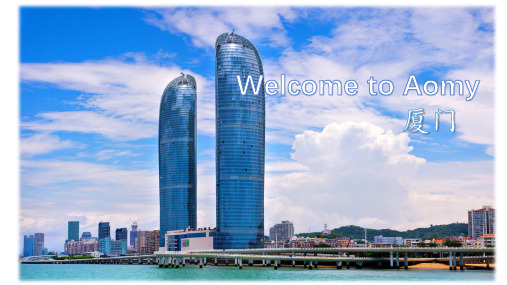
.
16
A journey of hearing
1.Xiamen Bailuzhou music fountain 2.Mingnan Dialect(闽南话)
.
17
.
18
.
11
Gulangyu 鼓浪屿
.
12
Nanputuo 南普陀
.
13
14
.
Zhongshan Road
中 山 路
A journey of taste
烧肉粽
厦门肉粽是一道美味可口的名点, 属于闽菜系。福建厦门的烧肉粽 历史悠久,具有香甜嫩滑,油润 不腻,精工细作等特点粽子在福 建各地都有不少品种,有咸粽、 豆粽、甜粽、肉粽等,独数厦门 肉粽最有名。厦门肉粽味道香甜, 油润不腻,色泽红黄闪亮,富有 引人品尝的吸引力。
笔山路
鼓新路
四落大厝
三一堂
杨家堂
Lunch time (11:30am-12:30pm)
Afternoon (13:00pm-5:00pm)
菽庄花园
钢琴博物馆
日光岩
日本领事馆
天主堂
.
6
Itinerary of 2.5-day trip
• DAY THREE:
Xiamen University
After breakfast
.
1
1. Perfect for a 2.5-day trip 2.Low budget 3. spring all the year round 4.A journey of sight, taste, and hearing
.
2
Xiamen is perfect for a 2.5-day trip
- 1、下载文档前请自行甄别文档内容的完整性,平台不提供额外的编辑、内容补充、找答案等附加服务。
- 2、"仅部分预览"的文档,不可在线预览部分如存在完整性等问题,可反馈申请退款(可完整预览的文档不适用该条件!)。
- 3、如文档侵犯您的权益,请联系客服反馈,我们会尽快为您处理(人工客服工作时间:9:00-18:30)。
Zhongshan Road (7:00-9:30)
Reture to Home Inn(22:00 p.m.)
Have an early rest(23:00 p.m.)
提问与解答环节
Questions And Answers
谢谢聆听
·学习就是为了达到一定目的而努力去干, 是为一个目标去 战胜各种困难的过程,这个过程会充满压力、痛苦和挫折
Special lunch: vegetarian dishes
Opening time: 12:00-14:00,17:00-24:00 (Monday-Friday)
The whole Day (Saturday-Sunday, holidays, summer and winter vacation.)
Snail Meat 螺肉 Price :10 yuan Taste :
• Chicken feet 无骨鸡爪 • Price: 25yuan/500g • Taste:
The Brazen Duck :赖皮鸭 Price: 28 yuan Taste :
• 2. White Байду номын сангаасall Beach • Travel mode:No.29 bus • Price: 1 yuan • Time: 30mins
Xiamen, I’m coming(6.1-6.4)
Trip Route
Day 1:Nanputuo Temple-Xiamen University-Cat Street Day2:Zengcuoan- White Wall Beach Day3:Sunlight Rock-Bright Moon Garden -Shu Zhuang
Garden
Trip Costs
Sum:1748yuan (4person)
Per capital: 437yuan
Hotel: Home Inn----3Days+3nights
600yuan
Tickets: Chaoshan---Xiamen high-speed railway
station (Round-trip ticket)
1. Zeng Cuo An: A place with lots of wonderful food
• Local Cuisine: Min Nan Rice Roll & Peanut Soup • Price: 10 yuan • Taste:
• Local Food : Shrimp and egg • Price: 25 yuan • Taste:
Enjoy the beach scenery
• Pick up a shell
• Twin Towers
Day 3 Koolangsu
Travel Mode: Take the bus No.841 Time: 7:40 a.m. From Home Inn to Inland Bay Terminal Price: 2 RMB per person
308yuan
Nei Cuo Ao Ferry Terminal
200yuan
Others costs: for bus staion
40yuan
For other landmark tickets For delicious foods
200yuan 400yuan
Preparation
Day 1
Learning Is To Achieve A Certain Goal And Work Hard, Is A Process To Overcome Various Difficulties For A Goal
The tunnel of the lotus
The lotus Lake
Valley Of Love
Jiannan Hall
Luxun Museum
Time: 3:00p.m. Travel Mode: On foot Xiamen University——Dingaozai Cat Street
Travel Mode: Take a ferry Time: 9:00 a.m.- 9:30 a.m. Price: The round-trip ticket, 50 RMB per person.
Route Planning 9:30-12:00
Sunlight Rock
Bright Garden Shu Zhuang Garden
Dingaozai Cat Street
Return to Home Inn
Day 2
• 1. Zen Cuo An (曾厝垵) • 2. White Wall Beach (白城沙滩)
• Travel mode:No.15 bus • Hotel: Home Inns • Price: 1 yuan • Time: 1 hour
• Local Food : Oyster Omelet (海蛎饼) • Price: 20 yuan • Taste:
• Local Food : Big Mango • Price : 8 yuan / 500g • Taste:
• Roast Pig Feet 烤猪脚 • Price: 25 yuan • Taste:
Nanputuo Temple
Xiamen University Dingaozai Cat Street
Time: 9:00 Travel Mode: On foot Home Inn ——Nanputuo Temple
9:20
Pray for happiness and good health
The panoramic view of Xiamen
Zheng chenggong statue
12:00-14:00
Lu Amo’s Craftsmanship
Grass jelly Peanut soup Manual pasty
The beach in koolangsu (14:30-17:30)
